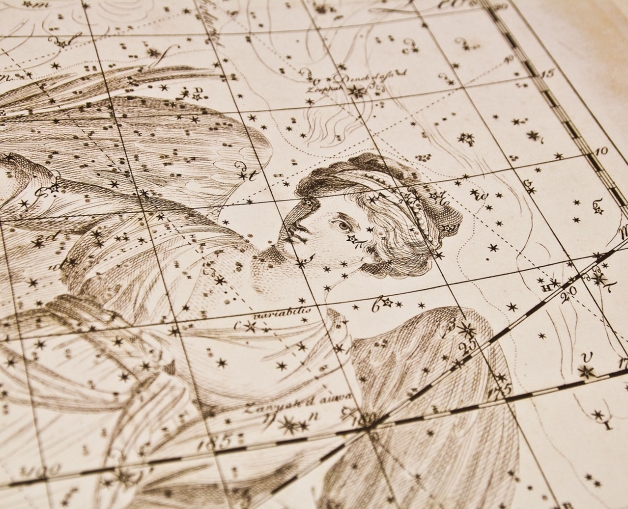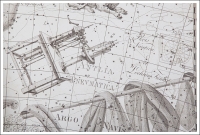Uranographia
Uranographia is a real masterpiece of engraving in the form of large-scale maps of the sky. The power of imagination created a world of human figures, animals and phenomena inherent in stellar constellations. Can you find them?
Limited Edition: 299 copies
Available: less than 4 copies
Joannis Elerti Bode, Uranographia sive astrorum descriptio, Berlin, 1797-1801
The 18th century is often called the age of astronomical discoveries. Owing to Newton's laws of motion that now seem so simple and obvious, astronomers finally became equipped with solid grounds for their calculations. Furthermore, the invention and perfection of the telescope allowed them to study heavenly bodies that previously could not be seen from the Earth. The greatest discovery of the time owes its name to German astronomer Johann Elert Bode.
Johann Bode - Early life
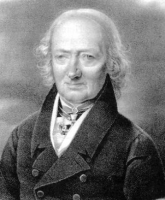 Johann Elert Bode
Johann Elert Bode
more >>
Johann was born on 19 January 1747 in Hamburg as the son of Johann Jakob Bode and Anna Margharete Kruse and was the eldest of nine siblings. He never attended a regular school and was educated by his father who wanted to train the son in his profession in an attempt to find a continuator for the family business. In his youth Bode suffered from an eye disease which later caused problems with sight in his right eye and serious problems with both eyes in the later years. His father's efforts did not match the boy's interests. Bode was absorbed by mathematics, geography and astronomy.
In 1765 the young amateur scientist was introduced by a famous physicist, his father's acquaintance, Heinrich Reimarus, to a professor of mathematics in Hamburg – Johann Georg Büsch. The latter, intrigued by his calculations and works, allowed the young Bode to use his private library, as well as astronomical instruments to facilitate his further education in a more professional environment. In 1766, when Bode was 19, he made his first scientific publication about the eclipse of the Sun on 5 August 1766. However, among his earliest works, the most prominent is the description of the transit of Venus (i.e. transit of the plant across the Sun's disk, so that to the observer Venus and the Sun are in one line) from 3 June 1769 and observation of comets.
First Achivments
In 1768, persuaded by his mentor, Johann Büsch, Bode published his first book Anleitung zur Kenntnis des gestirnten Himmels, i.e. Instruction for the Knowledge of the Starry Heavens. In the second edition of the work from 1772, he formulated the so-called Titius-Bode law that brought him fame. This is a hypothesis whereby the mean distances of planets to the Sun fulfil a certain arithmetic equation. It was presented and discovered by Daniel Titius, a professor of physics at the University of Wittemberg, and published and popularized by Bode. This law was correct for to all planets known at the time (including Saturn), but left an empty space between Mars and Jupiter, which, according to the hypothesis, should be occupied by some planet or other heavenly body. Already the famous Johannes Kepler wondered why there was a fairly large gap between Mars and Jupiter. Isaac Newton perceived this empty space as evidence that Providence found a way to restrict the gravitational pull of two huge and massive plants – Jupiter and Saturn. Others proposed a simpler and physical reason for the gap – they considered a planet that no longer existed due to a collision with another heavenly body – a comet or asteroid. At the beginning of the 19th century, Giuseppe Piazzi from the southernmost European observatory in Palermo noticed a celestial object in the sky that apparently changed its position, so it could not have been a star, but rather an object belonging to the Solar System. However, it quickly turned out that the new element was smaller than the Moon. In March 1802, further objects were discovered with diameters less than 400 kilometres. Due to their small sizes these were called planetoids. By 1891, 300 planetoids were found, and the rate of discoveries grew along with the emergence of more advance methods for observing the sky. Currently the belt of planetoids is considered to be a remnant of myriads of small objects that failed to coalesce into a planet because of the gravitational pull of Jupiter. If these indeed were fragments of a planet torn to pieces, orbiting in accordance with the Bode law, their orbits would intersect at the point of the disaster and once again on the opposite side of the Sun.
Shortly after the second edition of his book was published, Bode sent a copy to Johann Heinrich Lambert, a famous Swiss astronomer and mathematician, who became interested in the hypothesis and started corresponding with Bode to exchange comments and views. As a result, Bode is widely considered to be the discoverer of the hypothesis, rather than Titius (who formulated it earlier) and it was Bode who was given a position in the Berlin Academy of Sciences. In August 1772, he travelled to Berlin where he accepted the nomination along with the tile of professor. At the time, the chief astronomer of the academy and director of the observatory was one Johann Bernoulii, who nevertheless did not have much interest in observing the sky. As opposed to him, Bode, having gained access to such a professional place of work, barely left the observatory. Together with Lambert in 1774 he founded a German magazine devoted to astronomical discoveries entitled Astronomisches Jahrbuch oder Ephemeriden, i.e. Astronomical Yearbook or Ephemerides, later simply called the Berlin Astronomical Yearbook. After Lambert's untimely death in 1777, Bode kept publishing it by himself, nearly to the end of his life.
In July 1774, Bode married Joanna Christie Lange. The couple went on to have four children. Unfortunately, Joanna died shortly after giving birth to their fourth child. In the same year Bode married her elder sister, Sophie Dorothea Lange, who gave him one son, but also died shortly after the wedding so Bode remarried again, this time he wed Charlotte Wilhelmine Lehmann; they had another three children. Though the mortality rate in the 17th century was not as high as before, surviving labour was not obvious, even in upper social classes.
 Bode’s Galaxy
Bode’s Galaxy
more >>
In 1774 Bode took to searching new stars and nebulae in the sky. He observed and documented twenty of them. Among these three turned out to be discoveries never before observed by other astronomers. He also discovered many comets; one of them observed in 1779 was named after Bode. Yet his greatest discovery was observing galaxy M81, widely known as "Bode's Galaxy" or "Bode's Nebula".
Big discover
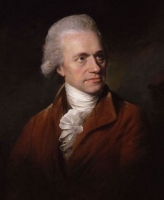 William Herschel
William Herschel
more >>
Meanwhile, in 1781, Bode's Law concerning the distance of plants from the Sun was sensationally and completely unexpectedly confirmed. Wilhelm Herschel, a musician from Hanover, became the first modern discoverer of a new planet of the Solar System. Apparently, Herschel had quite some free time from his duties related to his position as instructor of a military band and conductorship, as he was a keen learner of mathematics; he was also interested in optics and astronomy. As an amateur he started studying the issue of the distances of stars. In 1773, he borrowed a small telescope to soon make a discovery made by so many others before him – that a small telescope only wetted the appetite for a larger one. These, however, were too expensive, Herschel though found out that the most expensive part of a reflecting telescope, i.e. the mirror, can be made at home. Of course, his initial attempts to professionally cast and polish a mirror, i.e. the most important element of such a telescope, failed. However, he finally managed to produce a professional and quite powerful tool. Later, Herschel specialized in producing powerful telescopes. This novice enthusiast of astronomy was not fully aware of the speculations concerning the existence of further plants. His primary interest was stars. On 13 March 1781 he observed an object previously considered by astronomers to be a star. However, the qualitative advances in telescope making in the last century, coupled with Herschel's observing talents allowed him to notice something extraordinary about the object – as he himself noted, he observed "something strange, possibly a nebula or a comet". If the newly discovered object was a part of the Solar System, it should move in relation to the starts. After conducting systematic observations, Herschel established that this was indeed the case, though he still only considered it to be a comet. He told fellow astronomers (Neville Maskelyne, a royal astronomer, and professor of astronomy at the Oxford University, Thomas Hornsby) about the discovery, but they initially were unable to spot the alleged comet; however, having successfully done so, they concluded it was a planet. This was the first discovery of a new planet since the beginning of times, a discovery that doubled the size of the Solar System, because the new planet revolved around the Sun some 1 300 million kilometres further than Saturn, previously considered to be the most distant star. What is more, the new planet fit the Titius-Bode formula. It turned out that it had been observed on numerous occasions before, but was always considered a star. This fact prompted later astronomers to seek further planets and discover Neptune.
Bode and his contribution in naming new planet
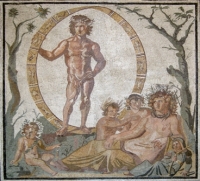 Uranus
Uranus
more >>
Herschel received a royal salary (his hobby now turned into a profession, and music a pastime) and called the new object Georgium Sidus (i.e. George's Star) out of gratitude for his royal patron, George III, although the planet owes its final name to Bode. The term Georgium Sidus, for obvious reasons, was not widely popular outside the United Kingdom and soon other names emerged. One proposal called to name the planet in honour of its discover, Herschel or Neptune, which was also appreciated in England due to the recent victory of the British Navy in the war of American independence; others sought to find a consensus by naming the new discovery "King George's Neptune" or "British Neptune". Meanwhile, Bode proposed that the new planet be called Uranus, from the Latinised form of the Greek god Uranus. He argued that similarly as in mythology, where Saturn was Jupiter's father, the new planet should bear the name of Saturn's father. This solution, stripped of any signs of British ambition to colonize the sky too, quickly gained popularity. In 1798, Bode's colleague from the Academy of Sciences, Martin Klaproth, in support of his recommendation, called the element he discovered uranium. Finally, the name proposed by Bode became so popular in continental Europe that the subjects of the King of England had no choice but to accept it. It is worth mentioning that Uranus is not the only planet whose name is derived from the Greek, rather than the Roman mythology, though these intertwine. Jupiter is the counterpart of Zeus, Saturn of Kronos, whose father was Uranus. The latter is considered to be the mythological creator of astronomy. Another interesting fact concerning Uranus is that it is the only planet with its axis in the plane of its orbit. Its revolving motion is compared to a rolling ball, and Uranus' equator is nearly vertical.
The greatest work of Bode - Uranographia
Bode was keenly interested in the discovery of the new planet, he not only named it, but also in his Astronomical Yearbook provided many examples of prior instances where it was unwittingly observed. At the time, after 1782, Bode became so engulfed with all issues pertaining to Uranus, publishing and his duties in the Academy of Sciences that he ceased to observe the sky as dutifully as before. In 1787, he became the director of the Berlin observatory, and in 1801 published his atlas of stars calling it Uranographii in honour of the recent discovery. The atlas is a spectacular collection of 20 maps of the sky with a catalogue of 17 240 stars and, a novelty in such atlases, nebulae (including those discovered by Herschel) or double stars. Uranographia sive Astrorum Descriptio (i.e. Uranography or Description of Stars), as this is the full title of the atlas, is a synthesis of numerous works of earlier astronomers, but also Bode's own discoveries (of which some where invalidated after more powerful telescopes were invented). This is a combination of astronomical observations and scientific investigations with an artistic interpretation of constellations as persons, animals or phenomena inscribed into the map of the sky. This was the last atlas to be a scientific work and work of art at the same time, the last from the golden age of the cartography of the sky, and the greatest publication of such type. It was published in five parts from 1797 to 1801. This collection contains nearly all maps from those five parts.
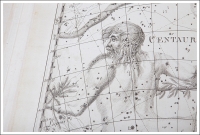 Uranographia
Uranographia
more >>
The original comes from the collection of the Copernican Library in Toruń, where it arrived from the collection of the Toruń library of the Protestant Academic Gymnasium founded in 1568 by mayor and humanist Henryk Stroban and later Coppernicus-Verein für Wissenschaft und Kunst in Toruń. It was purchased by the Toruń institution after it was published in Berlin for the purposes of educating students and remained in the Toruń collections as an extremely valuable work.
It was printed using the offset method on smooth paper. Uranographia is hand-bound in stamped parchment, canvass and leather, and the title of the front cover is gilded. The distinctive sowing and gluing of the leafs of the atlas allows it to be opened fully and flatly to expose the star maps without loss of details on bends.
The author and publisher of this atlas, Johann Bode, retired in 1825 after nearly 40 years of working for the German Academy of Sciences. He is famous not only for his astronomical discoveries, naming one of the planets of the Solar System, but also, maybe even above all, for his intense publishing activity. He died in 1826 in Berlin while working on the Astronomical Yearbook for 1830. As a scientist and publisher who had a great contribution in the development to astronomical sciences, he was honoured as the namesake of a crater on the Moon, an asteroid, as well as the comet and galaxy he discovered.
Specification
Joannis Elerti Bode, Uranographia sive astrorum descriptio, Berlin, 1797–1801
Dimensions: 455 x 650 x 40 mm
Number of folios: 22
Paper: smooth paper
Binding: half leather, leather bound with canvass, gilded title, atlas folios glued and sewn as in the original, allowing the atlas to be fully opened and viewed without loss of details at the folds (binding could be different from what you see on the pictures)
Packing: not forseen
Limited print-run: 299 copies Available: less than 199 copies
Price: 1300€


